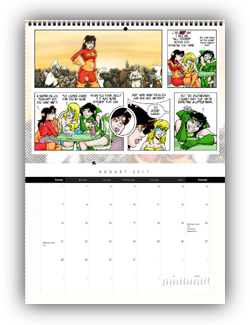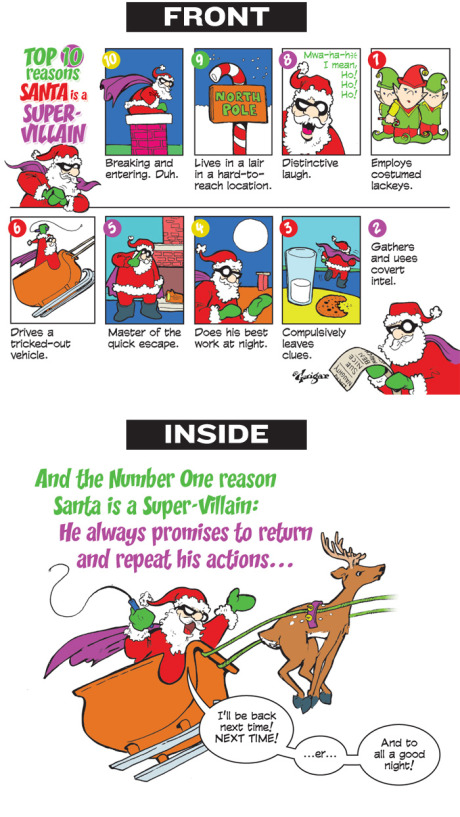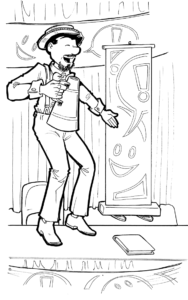Anatomy of a convention banner
Recently, I saw a webcartoonist asking for advice on convention banners. Here’s my advice:
The content you are trying to access is only available to members.
Recently, I saw a webcartoonist asking for advice on convention banners. Here’s my advice:
The content you are trying to access is only available to members.
You don’t need a subscription to read today’s post!
This is a re-post from the Webcomics.com archive. If you’ve ever been curious about the kind of information, tutorials and advice that you’ll get as part of your subscription to Webcomics.com, this is a good example.
If you’d like to join the site, you can get a 12-month subscription for $30 — or you can get a one-month Trial for $5 … with no obligation after your 30 days expire. For less than three bucks a month, you can get a steady flow of information, tutorials and advice targeted towards your webcomic business — plus a private forum to discuss issues with other professionally minded cartoonists.
Merry Christmas — and Happy New Year!
Set down the sunblock, and step away from the pool. It’s time to start planning for December and January.
I know it’s hard to get into the spirit, but this is the time to start working on merchandise for the holiday shopping season. In recent years, webcartoonists have offered an increasing compliment of holiday goodies that have ranged from specialty T-shirts and mugs to holiday-themed greeting cards. And let’s not forget to add calendars to that list. Those will start appearing in stores by November — at the latest!
So, let’s take a closer look at some of those specialty products, and how we can start working now to be ready to compete when the snow falls.
I’ve been pretty dour on calendars as merchandise in the past, and, truth be told, I’m still not a huge proponent of the practice. As I’ve stated before, calendars have a very limited shelf life. Few people buy them after January. That means you either have to have a very strong, dedicated readership to pitch to or you have to go Print-on-Demand (POD) which brings the unit profit way down.
I am a fan of the calendar-creation tool at Lulu.com, and Redbubble.com seems to have a pretty snazzy set-up for calendars, as well. So, as long as I don’t invest too much time on it, I can usually justify putting out a POD calendar.
 Lulu gives you a choice between two sizes: a large-format calendar that measures 13.5 x 19 inches and a standard-sized one at 11 x 17 inches. The Redbubble calendars are 11.7 x 16.5 inches.
Lulu gives you a choice between two sizes: a large-format calendar that measures 13.5 x 19 inches and a standard-sized one at 11 x 17 inches. The Redbubble calendars are 11.7 x 16.5 inches.
For a step-by-step walkthrough of Lulu’s calendar-creation tool, read this archive post.
The large-format calendar (like the sample on the right) has a spiral-bound spine at the top, holding sheets of 13.5 x 19 -inch stock.
Dates: Are you confirmed on any convention appearances for next year? Semi-confirmed? Put it on the calendar! (Just make sure to be clear if any of these are tentative dates.) Other dates to note:
Pricing: Lulu allows you to set your own royalty, but try to keep the final price as close to $20 as possible (for the standard size). $30-range for the larger version.
Of course, you could buy a larger number of calendars for yourself, driving the unit cost down, and then try to sell them for a larger profit on your own site. You can do this through your POD vendor or you could invest in an offset print run. However, you risk buying too many and then being stuck with them in January when sales dwindle.
Of course, you can always use them as a loss leader to drive sales to your store later in the month.
When I released my 2010 calendar, it was November. And, truthfully, I figured this was plenty of time. One of my readers was very upset with me for releasing it so late.
I was perplexed. I couldn’t imagine anyone wanting to purchase a calendar before November, and yet, there was clearly a segment of my readership who had already completed their calendar-shopping for the year — and given the choice, they would have chosen my offering if it had been available.
So, this year, I offered my calendar in early-October. And my sales have been brisk.
But my new recommendation is to release your calendars at the beginning of September! I’ll get into why in a moment.
I realize that this advice is coming to you too late for this year, but you can put it in the back for your head for next year. (I’ll try to have a Friday Archive Dive on this post next year to remind you!)
But there’s an even better reason for having your calendar out early: Conventions!
How did I overlook that?!
I brought 20 calendars to New York Comic con this year, and I was sold out either Saturday night or early Sunday. They flew off the table.
Calendars have an edge on the convention table:
If I had those calendars on my table in Baltimore the month before, I’m convinced that I would have made a killing.
About midway through the convention in New York, one guy who was buying a calendar asked for a sketch inside it — the way I do with books.
How did I overlook that?!?
Thinking on my feet, I asked him what month his birthday fell in. He said “April,” and I flipped the calendar open to that month and did a special sketch, with one of my characters delivering birthday wishes.
Every calendar after that had a special sketch on purchaser’s requested month.
Even if you’re not planning to attend conventions in September, October or November, you should still plan to have your calendars prepped and available by September because if you do, you can order yourself a small stack and offer them on your Web site as Artist Editions.
Most storefront solutions include a way for the purchaser to communicate with the merchant. In PayPal, it’s “NOTE TO MERCHANT.” Advise your readers to indicate the month they want the illustration drawn in — and any birthday messages (if this is a gift for someone else, for instance) — and you’ve got a rock-solid early-Fall merchandise offering.
And your sketches could be simply your characters, or they could deliver birthday wishes, or they could contain references to the person’s astrological sign… the possibilities are endless.
Heck, you could do a very limited number of calendars with sketches on each day and sell it for a premium price.
A few years back, I launched a couple of Christmas cards and the response was so overwhelming, I vowed to start earlier the following year so I could take advantage of this opportunity better.
Designing Christmas cards — and let’s note here that the term “Christmas card” is being used as a catch-all phrase for all of the holiday cards that get purchased during the winter holidays — is a lot like designing T-shirts.
No one is going to buy one with your character(s) on them. No one is going to buy them with your strip re-printed on them (unless maybe it’s a single-panel comic).
What they are going to buy are cards that express your unique sense of humor or your identifiable illustration style. It’s perfectly fair game to swipe a punchline from a strip. And it’s perfectly OK if the card has little-or-nothing to do with your comic.
Take the this good advice about designing great T-shirts and apply it to your Christmas card concept.
Like I said, I produced two that year. Both are posted a little further down. The first one is related directly to the theme of my comic, but had content that had not appeared in the strip (yet). The second one was completely unrelated to the comic. Both sold well, although the one that matched more closely the “Evil Inc” theme sold a little bit better.
When you think about it, designing a greeting card is very similar to creating a two-panel comic. The cover is the first panel and the inside can be the second panel.
In fact, it’s an incredibly effective two-panel comic because it’s impossible to look ahead to the punchline and ruin the build-up. You can build a nice amount of suspense that will charge the pay-off nicely. For example…

Of course, you can also approach it as a single-panel comic — with a nice, themed message on the inside.

The usual online printers are already offering specials for people printing greeting cards for the holidays. PSPrint has offered as much as 60%-off. Overnight Prints has offered 50%-off on holiday-related printing.
Make sure appropriately-sized envelopes come with the order. If not, buy some, and factor that expense in to your final price.
Remember, you’re shipping off someone’s greeting cards. They need to arrive in good shape. I bought these cardboard boxes from Uline last year, and they performed beautifully.
Reader surveys are an excellent way to get a better feel for your audience. Does your comic skew towards female reader? Do they tend to be younger or older? What are their other interests? would they support a Kickstarter for a new book? What rewards would make them Patreon backers?
In fact, we’ve posted a helpful DIY tutorial so you can ask all of the questions you need to ask — without paying for a potentially-expensive service like SurveyMonkey.
But what if you’re not getting a very healthy response from your readers? Should you seek out additional respondents? Advertise for more input? Solicit other cartoonists?
Be very careful, your quest for more information could result in your getting very, very bad information. And that’s downright dangerous. Here’s why…
The content you are trying to access is only available to members.
I was recently interviewed for the Advance Your Art podcast, hosted by Yuri Cataldo, director of Business of Creative enterprises in the Department of Marketing Communication at Emerson College in Boston. Advance Your Art focuses on arts entrepreneurship, so it was right in the wheelhouse of what I discuss at comic conventions, books and here at Webcomics.com.
Our conversation went deep into a wide range of topics, including…
Why do I introduce myself as a cartoonist? Because I love watching the confusion on people’s faces when I do. My uncle’s reaction to my being a cartoonist a few weeks ago was similar to the reaction you’d get if you told someone you have cancer: “Oh? Well… <shrugs> I’m sure you’ll be OK…”
My introduction to comics. I tell the story about how I got hooked on comics when one of my uncles — a trucker — brought a box of coverless comics from the drugstore on his route. If I had gotten to the coverless Playboys and Penthouseshe had stashed in the bottom of the box, however, I might have never paid much attention to the comics.
Why there’s no such thing as talent. In fact, I think telling a young person that they’re talented is harmful to them. I explain why.
The importance of a college education to a cartoonist — but not the way you think it might be. Also, we talked about some of my favorite formative books on cartooning from my childhood — including How To Draw Comics the Marvel Way and The Complete Book of Cartooning.
How I got started in newspapers — and, later, made the switch to webcomics. It all started with an editorial cartoonist — Bill Day — giving me some life-changing career advice: “Don’t sit around waiting for someone to die.”
The (un)importance of ideas. Here’s another artistic concept I think we get dangerously wrong. We focus on getting an ideainstead of putting our creative energies towards the really important stuff — executing the ideas we do have in a new and innovate way.
Why I don’t talk about new projects.
The early days of webcomics: The “free” comics fallacy and the Print vs Web wars. If you missed the first part of the 2000s in comics, you’ll want to hear this.
The rise of adblockers: The business of webcomics is in flux as we speak. We talk about what’s working and where the industry is going.
How can newspapers survive? I lay out a very simple plan. Really.
The stories behind the creation of Evil Inc, Courting Disaster and Phables.
How the “How to Make Webcomics” book came about — and, later “The Webcomics Handbook.”
The importance of knowing how to run a business is just as important as learning your art.
How to do social media better. Ironically, the thing that makes you great at art also makes you lousy at social media. And if you want to read even more on this topic…
This is the last of the latest series of Hitch It / Ditch It critiques.
The rules are simple: I go to your site and point out something you’re doing well, and something that might stand some improvement. The discussion goes on from there are the members join in with their thoughts.
Today, we’re going to be talking about…
The content you are trying to access is only available to members.
Patreon’s announcement — in an e-mail to creators — that it will once again be able to offer its users to use Paypal to pledge to NSFW creators is a huge victory for the crowdfunding service. Patreon had to remove Paypal functionality for creators who were offering NSFW content after Paypal threatened to stop all payments to Patreon.
Why’d they do that? It’s not a moral issue. It’s an economic one. From the standpoint of Paypal, an adult-oriented website is problematic due to the high volume of contested charges. What’s a contested charge? Take for example someone whose spouse questions an adult-website charge on the family credit card prompting an immediate defense of “I didn’t do that! There must be some mistake! One of the kids! Identity theft! Wandering bands of marauders!” They file a complaint with their credit-card provider which, of course, sides with its customer. The money is returned to the customer by the adult website — in a process called a “chargeback.” It causes additional transactions, processing time, and record-keeping.
As a result of all of those shenanigans, adult websites face annual fees of upwards of about $500 — as well as higher processing fees — from credit-card processors. They’re considered high-risk merchants. And when Paypal found out there was NSFW content on Patreon, they made the move to classify the crowdfunding service as “high risk.”
From Patreon:
“Unfortunately, this is a common issue in the payments industry, both because payments for adult content are subject to a higher rate of chargebacks, and because of an aversion to the content itself among some payment processors.
After many long discussions we were able to convince PayPal, or more specifically their subsidiary Braintree, that Adult Content creators on Patreon are not a serious risk. Our content policy, and the nature of subscription payments, means that Adult Content creators on Patreon are less risky than most creators making adult content. We also have a very diverse mix of content types, so even if our Adult Content creators are higher risk than other types of creators, Patreon as a whole is less risky.
We are very happy about this victory, but the payment industry does not provide much transparency around payments for adult content. As a company we are not happy with this lack of transparency since it impacts the livelihoods of Adult Content creators. We will continue to work towards more certainty around these issues, but for now we feel that the benefit of allowing PayPal payments for Adult Content creators outweighs any hypothetical risk that it may change in the future.”
Patreon also made the following announcement:
“We have changed the name of our NSFW flag to Adult Content. This change, along with better onboarding and help documentation, is to help creators understand when they have to flag themselves as Adult Content, as well as removing the not-so-loved “NSFW” title. We are also continuing to clarify what content is acceptable when flagged as Adult Content and what content is not allowed on Patreon.”
I’m a proponent of keeping my comic’s Facebook Page separate from my personal Facebook profile. Mostly, it’s a common sense issue — some things that I may want to post on one may not be appropriate for the other (and vice vera).
But with Facebook’s announcement that they will begin downgrading content from Pages (to allow posts from users’ personal profiles to get higher prominence) I’m finding that administering two separate accounts has an unforeseen benefit as well…
The content you are trying to access is only available to members.
A funny thing happens when you write for a site like this, day after day.
You start to listen to yourself.
 Ever since 2010, I’ve posted here about how my attitude towards comic conventions have been changing. When we wrote the original “How To Make Webcomics” book, I wrote the chapter on comic conventions. I drew myself as a carnival barker, standing on top of a convention table, and most of the material in that chapter was very strongly geared towards using comic convention as a primary revenue source for webcomics.
Ever since 2010, I’ve posted here about how my attitude towards comic conventions have been changing. When we wrote the original “How To Make Webcomics” book, I wrote the chapter on comic conventions. I drew myself as a carnival barker, standing on top of a convention table, and most of the material in that chapter was very strongly geared towards using comic convention as a primary revenue source for webcomics.
And I still think they’re important.
But for years, I’ve been posting some very frank advice on the topic. In short, I don’t think you should go to a comic convention unless you have a very good chance of turning a profit.
There are only two other serious reasons to go to a comic convention: Promotion and networking. I don’t put a lot of value into the promotion that takes place at a comic convention. What we do is digital. If your promotion isn’t clickable, it’s not worth much. And networking? Again, I think it’s valuable — but not to the extent that I’m willing to go into the hole financially for it.
Which brings me to a few months ago, as I was staring down the barrel of yet another Comic Con International. It meant a roundtrip flight to the West Coast, a weeklong hotel stay, a week of eating-out, and a very expensive booth — not to mention the weeks of lost productivity before the convention and the traditional week of recovery after the show.
All of this had to be weighed against an ever-dwindling percentage of profit earned at the show. You’ve heard it before, so I’m not going to belabor it. Comic Con International isn’t about comics anymore. It’s about blockbuster movies, TV shows, video games, autographs and pop-culture spectacle. Not only do the majority of the attendees buy their tickets for a dozen reasons that are prioritized above buying my merchandise, but they overwhelmingly expect the stuff on my table to be free giveaways — like those at the booths of the movie studios and video-game companies.
I called Dave Kellett, with whom I’ve split a booth in San Diego for years, and asked him if he wanted to buy my half of the booth. With the Strippped documentary nearing its release, he generously agreed, and I was officially not going to San Diego for the first time since 2001.
And I’m not going to kid you, it’s going to feel really weird when I know that all of my friends are going to be there. I’m going to miss seeing them, laughing with them, unwinding after the show with them… I’m going to be pretty sad about that.
But I know I made the right decision. To be honest with you, I’m taking a long, cold look at New York Comic Con next. It’s another expensive convention in an expensive town. I made good money there last year, but it’s costing more and more to do so.
But that’s part of running a business — making tough decisions. I’m getting a much better return-on-investment out of concentrating on my Kickstarter campaign this past week than I’ve ever clear at San Diego and New York combined. And that’s really hard not to pay attention to.
So I’m getting down from the convention table and removing my red-and-white-striped carnival-barker shirt.
Step right up! Step right up! Come see the man who heard his own voice after three years!
So that piece originally ran in 2013. It’s been three years now, and getting off the Comic Con International treadmill was one of the smartest moves I ever made for my business.
I’m seeing posts made by my colleagues who are frantically trying to prepare for the show this month, and I’m so glad that it’s not me. I’m not staring down the barrel of four-digit expense tallies. I’m not dreading walking onto that show floor and being drowned out in the noise. I’m not hoping I’ll make enough money to justify losing three weeks of productivity — one in prep, one in doing, and one in recovery.
I’ll miss a few things about Comic Con. I’ll miss seeing the friends that I used to look forward to seeing there year after year. And the loyal readers who used to stop by the booth to buy the latest books and chat for a while. But after that, the list drops off precipitously.
The fact of the matter is this: I’ve done better financially since restricting my convention schedule.
There are a few reasons for this.
First, as it has become increasingly difficult to turn a profit at many of these shows, I have simply eliminated an expense by saying no to more convention appearances.
Secondly, convention appearances require a significant amount of time — to prepare for, to attend, and to recover from. This is particularly true if the show requires travel. More time doing these activities means less time for the things that are bringing money into my business.
And that brings me to my third reason — Kickstarter and Patreon. I’m currently working on fulfilling the orders for a successful Kickstarter campaign. By the time those books get out into distribution, they will be responsible for thousands in revenue. Furthermore, the sooner I get this one off the books, the sooner I can launch my next Kickstarter campaign.
Meanwhile, my Patreon backers have completely changed the way I approach my business… and I’ll be darned if I’m going to disappoint them by missing updates. My time is best spent right here in my studio, cranking out a steady flow of content for my Patreon backers because that’s where the majority of my income is coming from these days.
I used to travel to almost a dozen conventions a year. This year it was three. And next year, it may be even fewer. And my bottom line has never been healthier.
It’s one of the many ways that the business of webcomics is completely different from it was when I started doing this in 2000. I think it’s time to take a long, hard, sober look at whether exhibiting at a comic convention is the right thing to do for your business. For me, the answer has never been so clear.
June was an excellent example of the tremendous value offered by a one-year subscription to Webcomics.com ($2.50 a month). My readers got early alerts on issues that would impact their businesses, helpful tutorials, insightful analysis, and meaningful feedback on their work.
If you’re curious about joining, we’ve made it easier than ever with a $5 trial membership. You’ll get full access to the site for thirty days so you can see what you’ve been missing. At the end of the trial, you can choose to re-subscribe ($30 for 12 months of access) or walk away with no strings attached. You will not be re-billed unless you choose to subscribe.

Patreon is rolling out a “Charge Upfront” payment feature in which patrons get charged immediately when they pledge — and then at the first of the month every month thereafter. This is an attempt to counteract “ghost pledging.” I was invited to beta-test upfront charging, and I share my analysis — and it’s not what my readers expected to hear.
In June, we launched another round of the popular “Hitch It / Ditch It” critique series. The rules are simple: I go to your site and point of one thing you’re doing well, and one thing that might stand some improvement. The discussion goes on from there as the members join in with their thoughts.
Lately, I’ve been re-doubling my efforts towards blogging. There are two reasons. First, with two updates a week, it’s not only more important to take that opportunity to try to get my messages across, but it’s much easier than when I was doing a daily strip. Secondly, now that my business has shifted from a ad-supported to a subscriber-supported model, it’s crucial that I try to make that blog a bigger part of my outreach.
What I have found is that I have been able to use my beefed-up blog as part of a greater social-media strategy as well. And it’s all thanks to a very simple HTML tag.
The latest Webcomics.com poll indicates another huge sea change in the webcomics business model. The question was simple: On which day(s) does your webcomic update. A surprising number of people indicated something that would have been spelled instant death a few years ago.
 A full 27% of the respondents indicated that the has no schedule for updates whatsoever.
A full 27% of the respondents indicated that the has no schedule for updates whatsoever.
It’s logical to assume that the rest of the results are from the 73% left over who do have an update schedule.
That makes that 27% much more significant.
Of the scheduled webcomics, Friday was the top response, with 35% of the responses. Wednesday was second popular.
That’s pretty interesting.
When I asked the same question in 2011, Monday was the most popular update day —with Friday a close second.
 I’m convinced that the way Manga Studio (aka Clip Studio Paint) handles lettering is one in a long list of features that makes it a superior comics-creation software package.
I’m convinced that the way Manga Studio (aka Clip Studio Paint) handles lettering is one in a long list of features that makes it a superior comics-creation software package.
I posted a video showing all of the above points in action.
You don’t need a subscription to read this post!
Don’t let anybody misinform you: Search Engine Optimization (SEO) matters, and it matters a lot. Although it should go without explanation, here’s why: Google is the Number One Web site in the world (with an estimated 900 million unique visitors a month). Yahoo is Number 3, and Bing is Number 10.
And most of those people are on those sites for one reason and one reason alone: They’re looking for content. It boggles my mind that the same people who are yearning to extend the reach of their comic beyond the “webcomics community” can’t see the value of SEO. It is — absolutely — your ability to reach new readers. And that’s what we’re all trying to do, right?
So, SEO… if you underestimate it, you’re making a grave mistake.

UPS is making two changes next month that are liable to affect your bottom line. It’s raising its shipping rates, and it’s reducing its “oversize” threshold.
Here’s a PDF describing the rate hike. The oversize threshold works like this: Previously, items that were over 60 inches on the package’s longest side qualified for an extra handling charge. That dimension has been reduced to 48 inches. So now, if you’re shipping something that measures over 48 inches on its longest side, you’ll be charged an extra $10.50 for handling.
Both changes are official on July 11, 2016.
 Q.: I have a webcomic that gets around 1500 pageviews a day. I’d thought of that as a small number, but I work in an online marketing company, and my boss and co-workers were telling me that I should be thinking of monetization. I’m not sure if I want to be focusing on that yet (I’ve been reading a lot of the articles here on writing and sitcom structure, and improving the actual comic is my short-term goal), but I’m wondering if this is something I should be thinking about in the medium term.
Q.: I have a webcomic that gets around 1500 pageviews a day. I’d thought of that as a small number, but I work in an online marketing company, and my boss and co-workers were telling me that I should be thinking of monetization. I’m not sure if I want to be focusing on that yet (I’ve been reading a lot of the articles here on writing and sitcom structure, and improving the actual comic is my short-term goal), but I’m wondering if this is something I should be thinking about in the medium term.
A.: Take those pageview stats and Facebook Likes and throw them out the window. Here’s why…
 Q.: I was reading an article about some things new comic creators should do, and avoid. For the most part the article gave really good advice, however, one piece of advice struck me as odd and I was curious what others thought. It said that for new creators, a long episodic comic should be avoided, and in its place the creator should do something shorter. The reasoning was that new creators need experience in crafting comics and shorter story (maybe something over the course of a year) would help them build the tools necessary to do a long, episodic comic. I also want to be clear that I respect and love the creator who gave the advice. Just wanted to get others to weigh in and share some thoughts.
Q.: I was reading an article about some things new comic creators should do, and avoid. For the most part the article gave really good advice, however, one piece of advice struck me as odd and I was curious what others thought. It said that for new creators, a long episodic comic should be avoided, and in its place the creator should do something shorter. The reasoning was that new creators need experience in crafting comics and shorter story (maybe something over the course of a year) would help them build the tools necessary to do a long, episodic comic. I also want to be clear that I respect and love the creator who gave the advice. Just wanted to get others to weigh in and share some thoughts.
A.: I think that’s pretty smart advice — especially considering s/he’s talking specifically to people who are new to creating comics. And here’s why…
In May, I posted 12 Ways You’re Doing Patreon Wrong. In it, I advocated moving away from an ad-supported business model, and into a subscription-supported model. After one member read the piece, they asked:
Q. I have a question about this: Do you EVER provide the paid material to the general population? I.e. if Patreon subscribers get your NSFW work, will the visitors to your [public website] … see the archives one day? And if so, how?
A. A few days ago, I posted this under the Webcomics.com Twitter account:
Webcartoonists: It ain’t about the pageviews anymore. Once you let that sink in, you’ll rethink your entire publishing approach.
— Webcomics-dot-com (@Webcomicscom) June 13, 2016
…And this is a perfect example.
You don’t need a subscription to read this post!
 Having launched a couple successful Kickstarter campaigns, I’ve been doing a lot of “I make mistakes so you don’t have to” research for this site. Here’s a few things I learned and a few tips I’ve culled from from others along the way.
Having launched a couple successful Kickstarter campaigns, I’ve been doing a lot of “I make mistakes so you don’t have to” research for this site. Here’s a few things I learned and a few tips I’ve culled from from others along the way.
One of the most popular rules of thumb in character design is that each character should be so distinct that you can identify them solely from their silhouette. We talk about why this is important, and how to implement it in our work.
You don’t need a subscription to read this post!
I took a question on Twitter recently:
Would it be wrong to draw my comics on A4 paper? I find it hard to fill big spaces.
My answer was, of course. that he should do what he felt comfortable doing. 140 characters doesn’t leave a whole lot of room for art advice. But it made me think that perhaps some artists don’t understand the benefit of drawing larger than the final size of the strip.
One of the strengths of Manga Studio (Clip Studio Paint) is its perspective rulers. I posted a video tutorial about using those perspective rulers wisely to speed up (and improve) your drawing process.
 Facebook just announced a change that makes it more difficult to promote your comic through your Page. Here’s how that change will affect you — and some thoughts on how to address the situation. A similar crackdown on posts from Facebook Pages happened in 2014. My thoughts now are similar to my thoughts then.
Facebook just announced a change that makes it more difficult to promote your comic through your Page. Here’s how that change will affect you — and some thoughts on how to address the situation. A similar crackdown on posts from Facebook Pages happened in 2014. My thoughts now are similar to my thoughts then.
In short: If this is troubling news to you, then you’re doing social media wrong (and lazy).
It’s July. Comic Con International is in a few days. If you’re going, it’s time to triple-check your prep, start getting ready to travel and brace yourself for the upcoming Nerd Prom.
The content you are trying to access is only available to members.